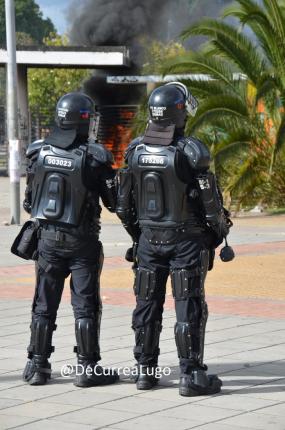Dilan’s murder was not an isolated act: it was the predictable outcome of orders given, operational methods adopted, weapons and ammunition issued, and training provided. Dilan became a symbol of national order. The series of excuses given by the government recalls the perverse logic used to explain the deaths of Dimas Torres and Flower Trompeta, both assassinated by the armed forces.
In the streets, after the attack on Dilan, the abolition of the Colombian riot squad — known by its Spanish acronym, ESMAD — became an undying demand on the part of demonstrators around the country.
Despite what the marchers have been saying, the utter absence of self-criticism by the police authorities and the government sent a message of total complacency as to the way the crime was carried out. Days after Dilan’s death, a number of perfectly peaceful demonstrations were held without ESMAD showing up, but in places where these heavily armed police did arrive, violence was the inevitable outcome.
Those of us who attend the marches have witnessed evidence of complicity between masked marchers and the police. We have seen police using various tactics to try and provoke peaceful demonstrators. They do this with the reassurance that when the next Dilan is killed, they will have the authorities’ support.
Along these lines, on the night of December 10 (Human Rights Day) in Bogotá, a student was detained by ESMAD and bundled into an unmarked car without being read her rights or told why she was being arrested. Thanks to a pair of brave drivers who followed the car, the young woman was finally released. The video, now circulating on social networks, recalls vivid scenes of violence wielded by Southern Cone dictatorships against students.
Just as the crime committed against Dilan was not an isolated incident, this kidnapping — carried out by various uniformed individuals and civilians with a private car — is not a spontaneous occurrence due to a few bad apples: it is a reflection of state policy. It would be nice if people who still doubt the necessity of abolishing ESMAD were to comment on a fact as palpable as this.
Colombia definitely has its heroes, including the people who followed the kidnappers’ car and got the girl released. Without the social networks and without civic solidarity, we could now very well be dealing with a case of forced disappearance, which is prohibited by the Colombian Constitution (which is already an embarrassing document).
ESMAD’s aggression cannot get more personal than this attack on a young woman who is representative of the great majority protesting in Colombia today. That is why it is urgent for the Minister of Defence to testify before Congress and be held accountable.
Looming in the background is an ongoing doctrine of military policing — the same doctrine that led to the bombing of children in Caquetá and served as a basis for the theory of the internal enemy, which was used against social movement leaders. It is the perverse logic of seeing every civic protest as a potential site of “terrorism.” This action even violates article 2.2.2. of the Havana Accords, which provides for the “protection of mobilization and peaceful protests.”
When you see this on-camera kidnapping, please do not reply to me that policemen have families too; that does not absolve them, but only further condemns them. As many memes remind us, the authorities are messing with the wrong generation: not only because young people have cameras and are willing to chase after kidnappers, but also, and most importantly, because this is a generation that has lost its sense of fear.
Translated from: http://victordecurrealugo.com/esmad-con-ese-de-secuestro/#
